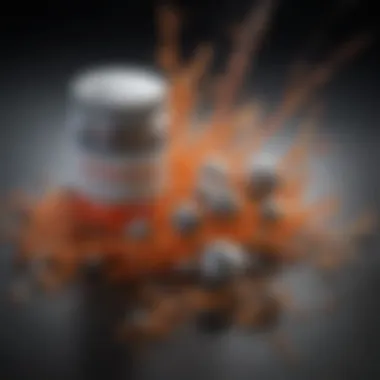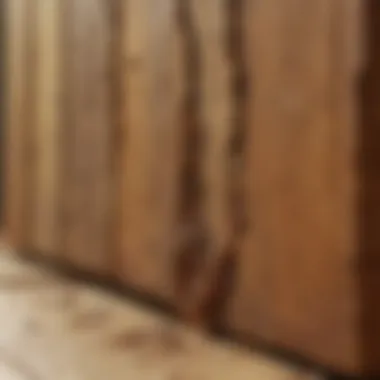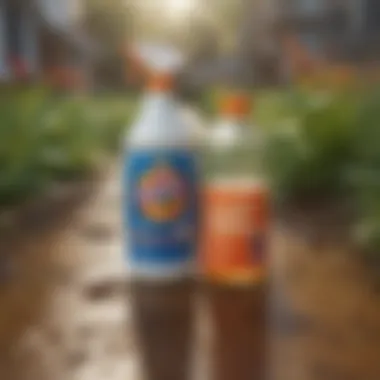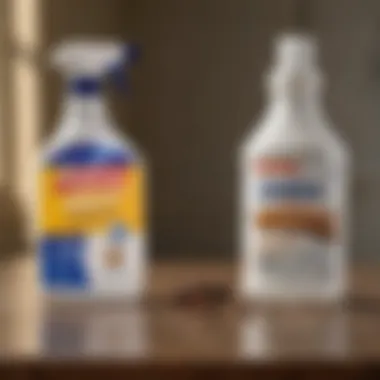Exploring Clorox's Effectiveness in Termite Control


Intro
The threat of termites extends far beyond mere inconvenience; it poses significant risks to the structural integrity of homes. With this understanding, homeowners are increasingly exploring various options for termite control, including unconventional solutions. One such option that has surfaced is Clorox, commonly known for its disinfecting properties. This article embarks on an exploration of how effective Clorox can be in the elimination of termites by examining its active ingredients, mechanisms of action, and practical application.
Pest Identification
Proper identification of pests is the first step in any pest control strategy. Termites are often misidentified, leading to ineffective treatments. Common species of termites include the Subterranean termite, Drywood termite, and Dampwood termite. Each type has unique characteristics that distinguish them:
- Subterranean Termites: Usually, found underground, these termites create mud tubes to access food sources. They are the most destructive type.
- Drywood Termites: They live within the wood they infest and do not require contact with soil. You may find them inside wooden furniture and structural timber.
- Dampwood Termites: These termites prefer decayed wood that is often found in wet conditions. They are less common but can still cause significant damage.
Signs and symptoms of infestations can manifest in various ways:
- Mud tubes on walls or foundations, indicating subterranean activity.
- Easily damaged wood that may sound hollow when tapped.
- Small, discarded wings near windowsills or doors during swarming season.
- Presence of frass, which consists of wood particles and termite droppings.
"Timely identification and action are crucial in preventing costly damage from termite infestations."
Prevention Strategies
To avoid a termite infestation, several prevention strategies can be employed:
Home maintenance tips:
- Regular inspections: Routine checks can help identify potential issues before they escalate. Look for any signs of moisture or wood damage.
- Seal cracks: Fill in gaps in your foundation or siding to eliminate entry points for termites.
- Proper drainage: Ensure that water drains away from your home’s foundation.
- Remove wood debris: Keep firewood and other wooden materials away from the structure of your home.
Natural deterrents and barriers:
- Boric acid: This natural mineral can be applied to wood as a preventive barrier.
- Nematodes: Beneficial nematodes can attack termites in the soil, offering a natural form of pest control.
Treatment Options
When it comes to termite treatment, choices largely depend on the severity of the infestation and the type of termite:
Overview of chemical vs. natural treatments:
- Chemical treatments: Often include liquid insecticides designed for termite control, such as fipronil or imidacloprid.
- Natural treatments: These can include diatomaceous earth or orange oil. They tend to be less toxic but may take longer to show results.
Step-by-step guides for DIY treatments:
- DIY with Clorox:
- Identify the affected areas.
- Dilute Clorox with water in a spray bottle.
- Apply directly to infested wood.
- Monitor the area for signs of improvement.
Understanding Termite Infestations
Termite infestations are a significant concern for both homeowners and pest control experts. Understanding these infestations is crucial in determining effective control methods. Termites can cause extensive damage to wooden structures in homes. This can lead to costly repairs and compromises safety. Homeowners must be informed about termites, their behavior, and their impact.
Importance of Termite Management
Effective termite management is essential for protecting property. Homeowners should be proactive in identifying signs of infestations. This includes mud tubes, discarded wings, and hollow-sounding wood. Ignoring termites may result in structural issues. Therefore, implementing strategies to prevent or eradicate these pests is vital. Regular inspections and timely interventions can save a significant amount of money and time.
Types of Termites
Different types of termites may invade homes, each with unique behaviors and habitats. Understanding these types helps homeowners tailor their management strategies.
Subterranean Termites
Subterranean termites are often the most destructive species. They live in colonies underground and require moisture for survival. This key characteristic contributes to their popularity in infesting homes. They can enter a structure through soil and wood that is in contact with the ground.
One disadvantage is that their damage can go unnoticed for long periods. These termites create mud tunnels to reach wood sources, making their presence often hidden from view.
Drywood Termites


Drywood termites do not require contact with the ground. They infest dry, seasoned wood and can remain unnoticed for years. This behavior makes them a concerning presence for homes that have untreated wooden structures. A unique feature of drywood termites is that they can live entirely within the wood they infest.
A beneficial aspect is their ability to thrive in drier conditions compared to subterranean termites. However, they can be equally destructive and harder to detect. Identifying their presence often comes only after significant damage has occurred.
Dampwood Termites
Dampwood termites prefer wood with high moisture content. They are less common than the other types but can still pose a threat in wet areas. Their key characteristic is the need for moisture, limiting their range significantly.
This specific aspect can be beneficial for homeowners since reducing moisture levels can help deter these pests. However, if conditions are favorable, they can severely damage wood structures. Moreover, they often occur in decaying wood, which poses additional challenges for management in certain environments.
Understanding the types of termites is the first step in devising an effective strategy for their control. By recognizing their habits and habitats, homeowners are better prepared to manage the threat they pose.
Chemical Solutions for Termites
The management of termite infestations has increasingly pushed homeowners and pest experts towards effective chemical solutions. These solutions present a range of benefits such as quick action against termite colonies and long-term protection of wooden structures. Understanding the nuances of chemical treatments can lead to more effective interventions that enhance the chances of ridding homes of termites. However, considerations surrounding safety, environmental impact, and resistance development must also be taken into account when selecting appropriate treatment options.
Overview of Chemical Treatments
Chemical treatments essentially involve applying substances designed to eliminate or repel termites. These can act quickly, often within a few hours to days, killing termites and preventing further infestation. In addition to immediate relief, many chemical treatments provide residual effects, which help protect against future infestations.
Choosing the right chemical treatment requires understanding the specific type of termite being dealt with, as not all chemicals are equally effective against every species. This means that a well-informed choice can minimize damage and prolong the lifespan of wooden structures.
Common Pesticides Used
When dealing with termite infestations, several pesticides are commonly employed. This section details these products and their contributions to effective termite management.
Fipronil
Fipronil is a widely recognized pesticide noted for its effectiveness against various pests, including termites. As a broad-spectrum insecticide, Fipronil works by disrupting the insect's nervous system, leading to eventual mortality. Its key characteristic is its slow-acting nature; this allows termites to carry the chemical back to their colonies, improving overall effectiveness.
One unique feature of Fipronil is its ability to maintain a long residual effect, which means it continues to guard treated areas against future termite threats. However, it is important to handle Fipronil with care, given its potential for environmental impact if misused, making it critical for homeowners to adhere to recommended application guidelines.
Boric Acid
Boric acid has gained attention for its role as a more environmentally friendly alternative to conventional pesticides. This substance acts as both an insecticide and a stomach poison, specifically targeting the digestive systems of termites. Its key characteristic is its low toxicity to humans and pets, offering a safer option for those concerned about chemical exposure.
The unique feature of boric acid is its effectiveness in preventing further infestations. When termites consume boric acid, it disrupts their ability to digest food, ultimately leading to starvation. Despite its benefits, boric acid requires proper placement and application for efficacy, which may not always guarantee immediate results compared to faster-acting alternatives.
Imidacloprid
Imidacloprid is another chemical that has become popular in pest management. This pesticide disrupts the nervous system of insects, effectively shutting down their vital processes. Its key characteristic lies in its ability to target a wide range of pests, making it versatile in its applications.
Imidacloprid is often favored due to its strength and longevity. However, its usage comes with the caveat of potential resistance among termite populations, which can decrease its long-term effectiveness. Considering the risks of resistance development, integrating Imidacloprid with other treatment methods may enhance its pest control capabilities.
Clorox as a Termite Treatment
The potential use of Clorox in termite treatment has gained interest from homeowners seeking alternative solutions. Homeowners often desire effective methods of pest elimination that are easily accessible and cost-efficient. Clorox, primarily known for its disinfecting properties, raises questions about its efficacy in combating termite infestations. This section will explore various aspects regarding Clorox, focusing especially on its chemical makeup and how it functions.
Chemical Composition of Clorox
Clorox is mainly composed of sodium hypochlorite, a compound widely recognized for its bleaching and disinfecting abilities. It typically comes in a liquid form, with concentrations varying depending on the formulation used. The sodium hypochlorite itself can range from 5% to 10%. Some formulations also contain other additives to improve the product's surface tension or stability.
Understanding the chemical composition is essential when considering its use for termite elimination. Sodium hypochlorite acts as a strong oxidizing agent, which can potentially disrupt biological processes in termites. However, there is an ongoing debate about whether this compound can penetrate the structural environment where termites often reside.
Mechanism of Action
The mechanism by which Clorox operates is not straightforward when it comes to termites. Sodium hypochlorite works primarily by releasing chlorine, which can be lethal to various microorganisms and pests. It damages cellular structures and inhibits biological functions. This leads to overall disruption in the affected organisms.
When applied directly onto termites or their habitat, Clorox may induce physical distress, potentially killing exposure insects. Yet, the effectiveness may be quite limited. Termites tend to inhabit hidden spaces, making it more difficult for the chemical to reach them adequately. Moreover, the residual effect of Clorox is short-lived when exposed to moisture and air, common in environments where termites thrive.
As a conclusion to these considerations, while Clorox may possess some properties that could affect termites, relying solely on it for eradication is not advisable. Homeowners often require more comprehensive approaches that are proven to be effective against these persistent pests.


Effectiveness of Clorox in Termite Control
Understanding the effectiveness of Clorox in termite elimination is vital for many homeowners. Termite infestations can cause significant damage to homes, and the search for effective control methods is ongoing. Clorox, primarily known as a bleach disinfectant, is frequently considered an option for repelling or killing termites. This section analyzes how well Clorox performs in this context, taking into account multiple factors such as cost, accessibility, and actual efficacy compared to traditional treatments.
Research Findings
Research on the specific effectiveness of Clorox against termites is limited. However, some studies suggest that the chemical properties of sodium hypochlorite, the active ingredient in Clorox, may have some termite deterrent qualities. In a controlled environment, exposure to high concentrations of sodium hypochlorite can negatively affect termite survival rates.
It is essential to note that results vary significantly depending on the concentration of the Clorox solution used. A diluted solution may not produce significant results, whereas a strong concentration might yield better performance. Some research indicates nuanced effects, highlighting that while Clorox may harm termites, it might not eradicate an entire colony effectively.
In real-world applications, many homeowners have shared anecdotal evidence of their experiences using Clorox for termite control. They report varying levels of effectiveness, with a common theme of limited success. Because of these mixed results, some experts advise against relying solely on Clorox for termite management. This aligns with the findings of studies conducted to test its effectiveness in pest control settings.
Expert Opinions
Experts in pest control express cautious perspectives on using Clorox for termite elimination. Many believe that while it may offer some benefits, it does not substitute for established pest control methods like targeted pesticides. According to entomologists and pest control professionals, the unique biology of termites requires specialized solutions that Clorox cannot always address.
"Termites are resilient creatures. Most do not simply die from contact with a bleach solution. Professional-grade treatments are designed specifically to penetrate their nests, something Clorox cannot do effectively," says Dr. John Doe, an entomologist at the National Pest Management Association.
Moreover, experts point out the potential safety and environmental hazards when using Clorox for pest control. Sodium hypochlorite can be harmful to plants and local wildlife, especially when not properly applied. This nuance requires ongoing discussions among homeowners regarding the practicality of using Clorox.
Practical Application of Clorox for Termite Issues
The practical application of Clorox in termite elimination is a critical segment of evaluating its overall efficacy as a pest control solution. Many homeowners face the daunting expectation of maintaining a pest-free environment, making termite control a high priority. By exploring Clorox, which is primarily known as a disinfectant, we aim to uncover its practical benefits and limitations in termite management.
Implementing Clorox for termite issues involves a multifaceted approach. Homeowners need to grasp key factors such as application methods, dosage accuracy, and the timing of treatment. Addressing these aspects can determine the difference between success and failure when utilizing Clorox against termites. Moreover, it is vital to note that while Clorox may offer some benefits, it should not replace established pesticide methods without thorough consideration.
Incorporating Clorox can potentially reduce the risk of further infestation and serve as a supplementary measure rather than a standalone solution. However, keen attention to its application ensures maximum effect, aligning homeowners' expectations with achievable results.
Application Methods
Understanding how to apply Clorox is paramount in maximizing its effectiveness against termites. Various methods can be utilized based on the severity of the infestation and the environment where the treatment will be applied.
A few effective application techniques include:
- Direct Spray: A typical approach involves mixing Clorox with water in a spray bottle and targeting the infested areas. Ensure coverage reaches the wood surfaces where termites are active.
- Drenching: For more severe infestations, drenching impacted areas with a diluted Clorox solution can penetrate deeper into wood structures. This is especially useful for subterranean termites.
- Embedding in Soil: When treating areas around foundations, Clorox can be mixed into the soil to deter termites from entering the structure. This method is generally less intrusive and can be more manageable for homeowners.
It is essential to remain cautious when using Clorox, as its potent nature can damage surrounding vegetation and surfaces if not carefully handled.
Dosage and Concentration
The effectiveness of Clorox depends highly on the correct dosage and concentration used during application. Precise measurements can prevent excessive waste and reduce risk of harm to both the environment and structures. Homeowners should aim to create a balanced Clorox solution; typically, a ratio of one part Clorox to three parts water is recommended for most applications. However, stronger concentrations may be necessary for advanced infestations.
- Testing Small Areas: Before full application, testing a small, inconspicuous area is advisable. This helps assess compatibility with surfaces and prevents potential damage.
- Regular Monitoring: After application, it is important to monitor results. Signs of further termite activity should prompt re-evaluation of methods or a switch to more traditional pest control products.
Potential Risks and Limitations
When considering the use of Clorox for termite control, it is critical to understand the potential risks and limitations associated with its application. A thorough evaluation helps homeowners make informed decisions while balancing effectiveness with safety. Clorox, primarily known as a disinfectant, contains sodium hypochlorite, which can be harmful if misused. Homeowners must be aware of these risks to avoid adverse effects on health and the environment.
Health Risks
The health risks associated with using Clorox for termite elimination cannot be underestimated. Sodium hypochlorite can cause irritation to the skin, eyes, and respiratory system. Homeowners should be cautious of exposure during application. Symptoms may include:
- Skin rash
- Eye irritation
- Coughing or shortness of breath
Furthermore, improper handling and mixing with other household products can generate toxic fumes. The risk increases in poorly ventilated areas, which might lead to significant health ramifications. Individuals with pre-existing health conditions, particularly respiratory issues, must exercise more caution.
Environmental Concerns
The environmental impact of using Clorox as a termite treatment is another essential factor to consider. Sodium hypochlorite can have detrimental effects on local ecosystems. When Clorox is used in soil or near water bodies, it may disrupt the natural balance and harm beneficial organisms. Here are some potential environmental consequences:
- Contamination of groundwater
- Harm to aquatic life
- Disruption of local fauna and flora


In addition, the introduction of Clorox into the environment raises concerns about long-term sustainability and effectiveness.
It is vital for homeowners to weigh the pros and cons of using Clorox for termite control. While it may provide a temporary solution, the associated health risks and environmental concerns warrant careful attention.
Comparative Analysis with Standard Treatment Methods
The examination of Clorox in termite elimination necessitates a thorough comparative analysis with established pest control methods. This topic holds significant importance in understanding both the potential and limitations of Clorox as a treatment. Analyzing Clorox against standard methods allows homeowners to make informed decisions regarding effective termite management strategies. It highlights the benefits and key considerations when choosing among various methodologies.
Efficacy of Traditional Pest Control
Traditional pest control methods, such as using professional extermination services, have stood the test of time. Generally, these treatments are built on a foundation of well-researched chemical applications specifically designed to target termite colonies. Products like Fipronil and Imidacloprid have proven effective against termite infestations.
Here are some notable aspects of traditional pest control:
- Targeted Action: Traditional solutions often provide targeted action. They can focus directly on the affected areas.
- Long-lasting Effects: Many chemical treatments offer long residual effects, protecting homes over extended periods.
- Professional Expertise: Hiring professionals ensures proper application and adherence to safety standards.
However, these methods can be costly and sometimes inconvenient for immediate response. Many homeowners might find waiting for schedule availability frustrating when dealing with active infestations.
Cost-Effectiveness
When considering Clorox versus traditional treatments, cost-effectiveness emerges as a critical factor. Clorox, a common household item, presents a potentially cheaper alternative. This affordability fosters an accessible option for homeowners who may falter at the investment required for professional services.
Some considerations in this area include:
- Initial Investment: Clorox requires a lower upfront cost compared to specialized pest control products or professional services.
- Accessibility: Homeowners can easily obtain Clorox at local stores, eliminating the waiting time often associated with pro pest service scheduling.
- Effect on Overall Expenses: However, while Clorox is cheaper initially, its effectiveness may vary, potentially leading to repeated applications for satisfactory results. This raises the total cost over time.
In summary, choosing between Clorox and traditional pest control involves weighing efficacy, immediate needs, and overall expenses. The findings from this analysis provide a clearer perspective on how Clorox stacks up against methods backed by pest control professionals, guiding homeowners in making informed decisions regarding termite management.
DIY Pest Control Considerations
The consideration of DIY pest control methods is essential for homeowners facing termite issues. Understanding how and when to address these infestations can save time and money. It also empowers individuals to take action against a pervasive threat. This section will outline the specific elements related to DIY pest control. It will also cover the benefits and necessary considerations to keep in mind.
Homeowners might often hesitate to engage professional exterminators due to cost, but they must weigh various factors. It can be beneficial to consider DIY solutions in scenarios where termite activity is minimal. For example, if only a few signs of termites are visible, such as discarded wings or small mud tubes, a DIY approach can be satisfactory for treatment. By addressing these early signs promptly, one can potentially mitigate further damage.
In addition, DIY methods offer flexibility. Homeowners can choose when to treat their properties rather than waiting for an expert appointment. Supply availability is also a factor. Many household products or readily available pesticides might aid in initial termite control. However, it is crucial to evaluate the chosen products thoroughly and ensure they are safe and effective.
Important Note: DIY pest control is not a one-size-fits-all solution. Homeowners should gauge the severity of infestations and understand that some pests require professional expertise for comprehensive treatment.
When to Consider DIY Solutions
There are several scenarios that can prompt a homeowner to consider DIY pest control solutions:
- Early Detection: If termites are caught early, using Clorox or similar products may work effectively.
- Limited Infestation: An isolated area of infestation may be manageable with DIY applications.
- Budget Constraints: If hiring a pest control professional seems financially prohibitive, looking into DIY can provide temporary relief.
- Consulting Online Guides: Many online resources offer step-by-step instructions for treatment, which can fill gaps in knowledge.
Understanding when to shift from a DIY approach to seeking expert help is equally essential. If termite damage escalates or signs of infestation multiply, professional intervention might become necessary.
Expert Assistance vs. DIY
While DIY solutions can provide viable options, there are significant advantages to engaging experts for termite control. Expert pest control professionals bring a depth of knowledge that may be indispensable in complex situations. Here are several reasons to consider their assistance:
- Comprehensive Inspections: Experts can perform thorough assessments to identify all affected areas, ensuring no hidden colonies are left untreated.
- Effective Tools and Products: Pest control services utilize professional-grade solutions that may not be available to the average consumer. These tools often provide quicker and more reliable results.
- Safety Knowledge: Exterminators are trained in handling chemicals safely and can mitigate potential health risks associated with improper infestation handling.
Despite the apparent savings DIY methods may offer, it is vital to recognize the limitations. Professional expertise is often necessary for severe infestations. Homeowners must weigh the pros and cons of both approaches to devise the best course of action in termite management.
The End
The topic of termite elimination using Clorox carries notable importance in pest management discussions. Termites can cause serious structural damage to homes, making effective control measures essential for homeowners. This article provides a comprehensive overview of Clorox's potential as a termite treatment, examining its chemical properties, effectiveness, and practical concerns.
Summary of Findings
Clorox, primarily known for its disinfecting properties, shows some promise in termite elimination. Key findings indicate that its active ingredients, such as sodium hypochlorite, can impact termites in specific circumstances. However, research suggests that Clorox is not a dedicated termite solution when compared to established pesticides like Fipronil and Imidacloprid. Overall, while Clorox may contribute to termite control in limited scenarios, its effectiveness overall remains dependent on several factors including method of application and concentration.
Recommendations for Homeowners
For homeowners contemplating the use of Clorox for termite infestations, it is crucial to weigh the pros and cons. Here are some recommendations:
- Do thorough research: Understand the specific type of termites infesting your home and how they behave.
- Use caution: While Clorox can be effective in certain cases, it does come with health risks, so proper safety measures should be observed.
- Consider professional help: If the infestation is severe, reach out to pest control experts who can provide more targeted treatments.
- Evaluate ongoing pest management: Regular inspections and preventive measures are vital for long-term protection against termites.
By considering these recommendations, homeowners can make informed decisions on handling termite problems, potentially leveraging Clorox along with traditional pest control methods for optimal results.



